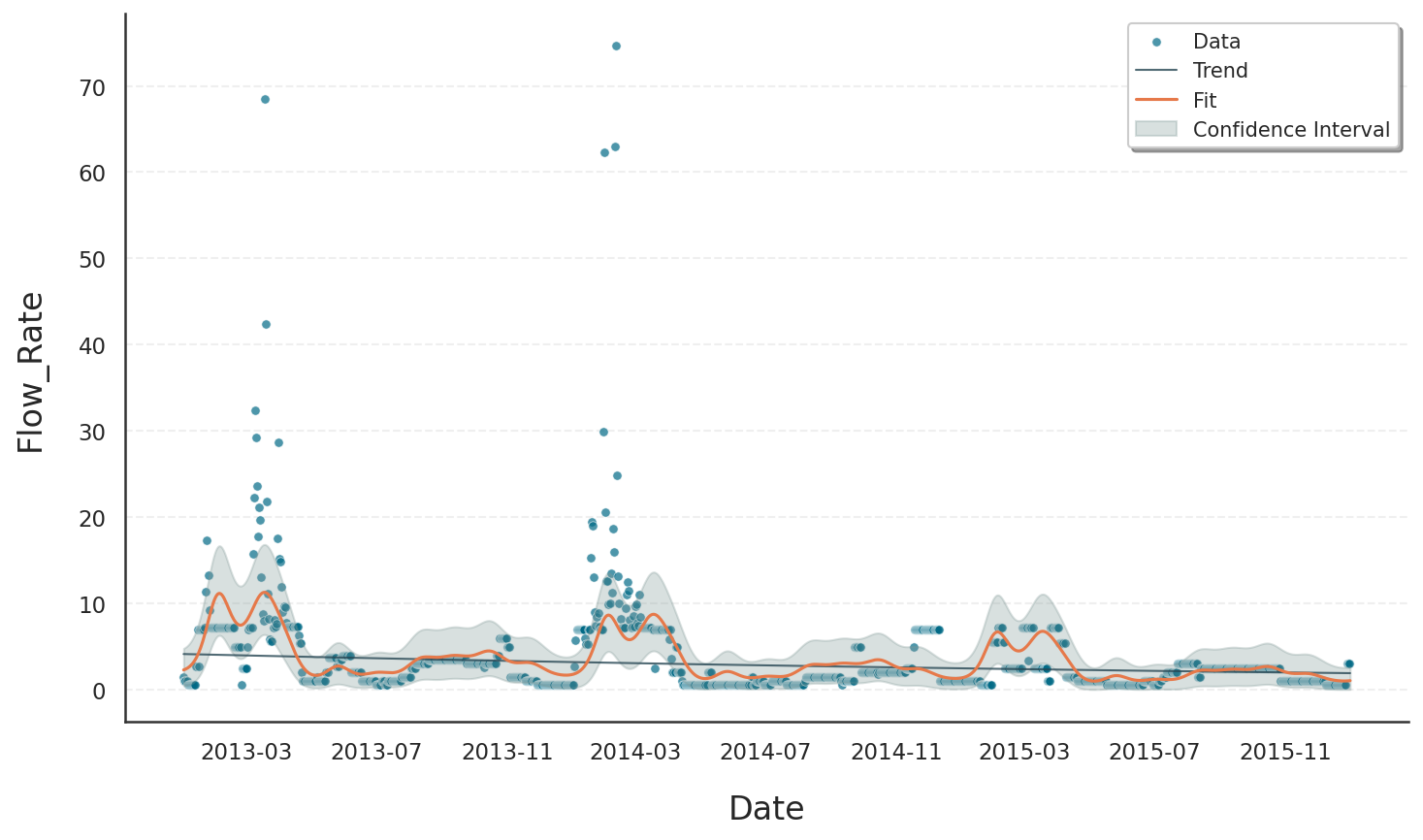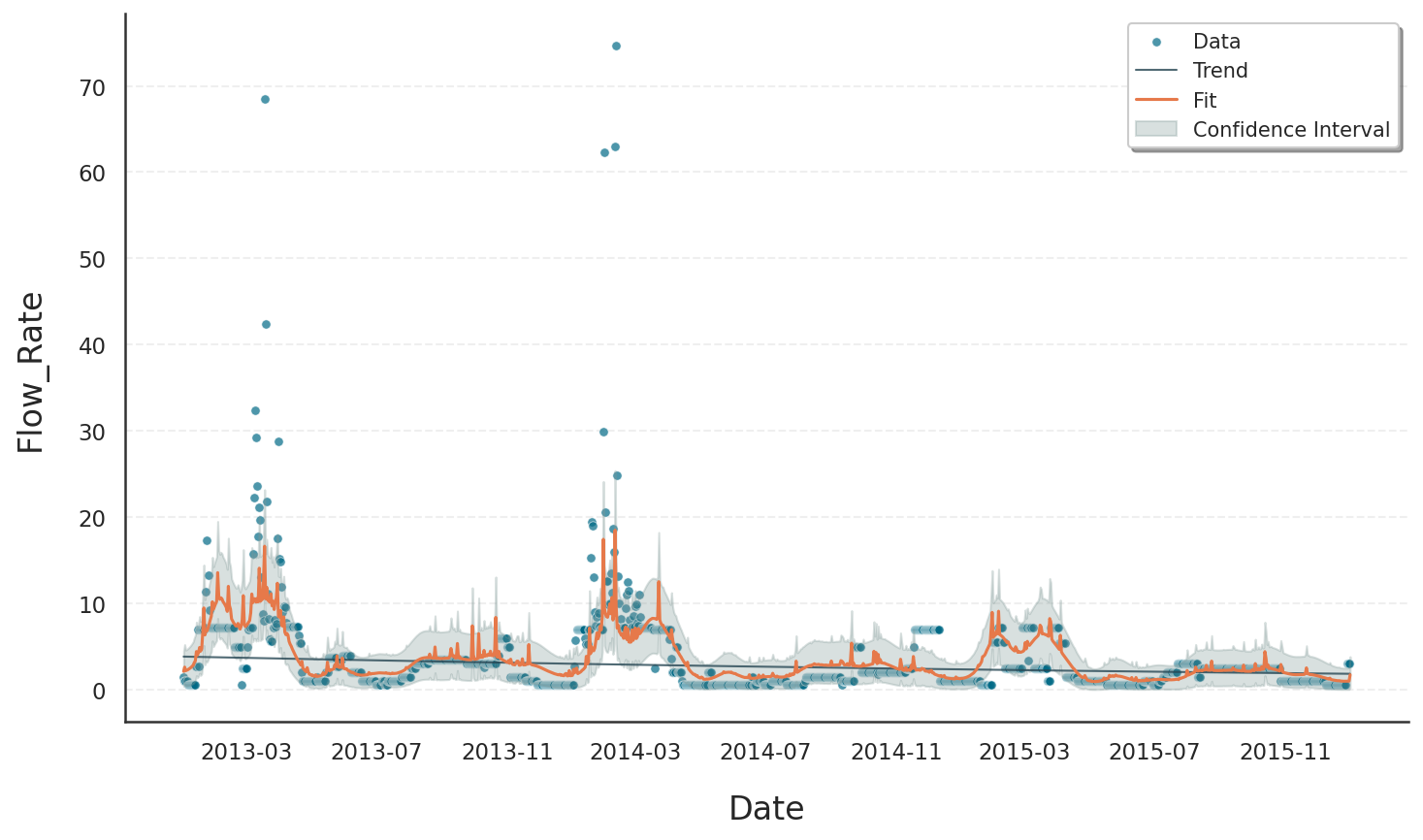External Regressors#
Incorporating external regressors can significantly improve the quality and interpretability of time series forecasts. While autoregressive models focus solely on the internal dynamics of a time series (e.g., trends, seasonality, autocorrelation), they may miss important exogenous influences, that is factors outside the series that systematically affect its behavior.
Typical examples of external regressors include:
Weather data
Economic indicators
Ignoring these variables can lead to biased estimates, unexplained variability, and underperforming forecasts.
Baseline Fit with Default Model#
We are going to use daily data showing the water level of Lake Bilancino in Italy [1]. The dataset originates from open hydrological measurements and contains several relevant variables, including:
Date: A timestamp column representing daily measurementsRainfall_X: It indicates the quantity of rain falling, expressed in millimeters (mm), in the area XFlow_Rate: It indicates the lake’s flow rate, expressed in cubic meters per seconds (mc/s)
This data provides an ideal basis for time series forecasting, particularly because flow rate respond both to internal seasonal patterns and external hydrological dynamics such as rainfall.
In the first part of this example, we restrict ourselves to the default model configuration, based on Gloria’s core methodology.
We start by applying Gloria with the following assumptions:
No changepoints to capture structural shifts in water level trends
A Gamma distribution to model a positive, right-skewed variation
Daily frequency (1-day sampling interval)
Yearly seasonality to account for periodic hydrological patterns
Let’s begin by preparing the data and fitting this baseline model.
# For loading and processing
import pandas as pd
# For forecasting and setting up Gloria
from gloria import Gloria, cast_series_to_kind, CalendricData
# Load the data
url = "https://raw.githubusercontent.com/e-dyn/gloria/main/scripts/data/real/Lake_Bilancino.csv"
data = pd.read_csv(url)
# Save the column names and data configurations for later usage
n_changepoints = 0
model = "gamma"
metric_name = "Flow_Rate"
timestamp_name = "Date"
sampling_period = "1 d"
# Convert to datetime
data["Date"] = pd.to_datetime(data["Date"], format="%d/%m/%Y")
# Restrict data
data_gloria = data[
(data["Date"] >= "2013-01-01")
& (data["Date"] <= "2015-12-31")
& (data[metric_name].notna())
].reset_index(drop=True)
# Sort data by Date
data_gloria = data_gloria.sort_values(by="Date")
# Set up the model
m = Gloria(
model=model,
metric_name=metric_name,
timestamp_name=timestamp_name,
sampling_period=sampling_period,
n_changepoints=n_changepoints
)
# Add seasonalities
protocol = CalendricData(yearly_seasonality=True, weekly_seasonality=False)
m.add_protocol(protocol)
# Fit the model to the data
m.fit(data_gloria)
# Predict
future_dates = m.make_future_dataframe(periods=1)
prediction = m.predict(future_dates)
# Plot
m.plot(prediction, include_legend = True)

Although a forecast is produced that formally satisfies the assumptions of the selected model - in this case, the Gamma distribution —- the results still reveal important shortcomings when modeling lake level dynamics without external regressors:
The Gamma distribution correctly ensures that predicted values are strictly positive and can handle right-skewed distributions, which is appropriate for many natural measurements like water levels.
However, because the model relies solely on internal patterns such as trend and seasonality, it cannot respond to external shocks or variations caused by hydrological drivers like inflow or drainage.
As a result, the forecasts may still miss critical inflection points or shifts in the data, especially during anomalous events or periods of sudden change.
In short, without external context such as the rainfall in specific areas, it cannot fully explain or anticipate the dynamics observed in the system, limiting both the accuracy and interpretability of its forecasts.
Improved Fit with External Regressors: Rainfall Inputs#
To improve model performance and capture the true drivers of variation in flow rate, we now extend the model by incorporating external regressors — specifically, rainfall measurements from the various catchment areas that feed into the lake.
Although the lake’s inflow and outflow (Flow_Rate) is a key driver of water level changes, this variable is itself influenced by upstream precipitation. By including rainfall data from multiple hydrological zones as regressors, we provide Gloria with causal context that improves its ability to explain and forecast future changes in lake level.
It is crucial that the external regressor data are available and clean for every time point in the historical dataset to ensure a reliable fit. Furthermore, for forecasting, corresponding regressor values must be known or accurately forecasted for future periods. For weather-related regressors like rainfall, this dependency is often manageable over shorter forecast horizons, where meteorological predictions are typically more reliable.
We continue to use the Gamma distribution, which remains well-suited for modeling positive, skewed, and continuous quantities like lake levels. However, the model now includes a structured regressor component that helps modulate the forecast based on real-world environmental inputs.
# For loading and processing
import pandas as pd
# For forecasting and setting up Gloria
from gloria import Gloria, cast_series_to_kind, CalendricData
# Load the data
url = "https://raw.githubusercontent.com/e-dyn/gloria/main/scripts/data/real/Lake_Bilancino.csv"
data = pd.read_csv(url)
# Save the column names and data configurations for later usage
n_changepoints = 0
model = "gamma"
metric_name = "Flow_Rate"
timestamp_name = "Date"
sampling_period = "1 d"
# Define regressor columns
regressor_name = ["Rainfall_S_Piero", "Rainfall_Mangona",
"Rainfall_S_Agata", "Rainfall_Cavallina",
"Rainfall_Le_Croci"]
# Convert to datetime
data["Date"] = pd.to_datetime(data["Date"], format="%d/%m/%Y")
# Restrict data
data_gloria = data[
(data["Date"] >= "2013-01-01")
& (data["Date"] <= "2015-12-31")
& (data[regressor_name].notna().all(axis=1))
& (data[metric_name].notna())
].reset_index(drop=True)
# Set up the model
m = Gloria(
model=model,
metric_name=metric_name,
timestamp_name=timestamp_name,
sampling_period=sampling_period,
n_changepoints=n_changepoints
)
# Add seasonalities
protocol = CalendricData(yearly_seasonality=True, weekly_seasonality=False)
m.add_protocol(protocol)
# Add regressors
for name in regressor_name:
m.add_external_regressor(name=name, prior_scale = 5.0)
# Fit the model to the data
m.fit(data_gloria)
# Predict
future_dates = m.make_future_dataframe(periods=1)
# All external regressors must be available for both the entire historical
# and future dataframes
if isinstance(regressor_name, str):
regressor_name = [regressor_name]
future_dates = future_dates.merge(
data[["Date"] + regressor_name], on="Date", how="left"
)
prediction = m.predict(future_dates)
# Plot
m.plot(prediction, include_legend = True)
The revised model leads to:
More responsive predictions that reflect external influences
Improved accuracy by incorporating causal drivers
Confidence intervals that adapt to changes driven by regressors
Enhanced interpretability through inclusion of meaningful external factors

Summary
Incorporating external regressors into time series models like Gloria can substantially enhance forecast quality and interpretability. While traditional models capture internal dynamics such as trend and seasonality, they often miss crucial exogenous drivers that influence the target variable.
By including meaningful external regressors, the model benefits from:
Greater responsiveness to real-world events and external shocks
Improved explanatory power by linking observed variations to causal factors
More accurate and robust forecasts with adaptive confidence intervals
Enhanced interpretability, enabling stakeholders to understand key influences on the series
Reliable performance only when regressor data is consistently available—both historically and (via forecast) into the future
In practical applications, ensuring the availability of external regressors for both historical and future time points is essential to fully leverage their predictive potential.
Overall, extending Gloria with external regressors allows for richer, context-aware models that better reflect the complexities of real-world systems.
Footnotes

